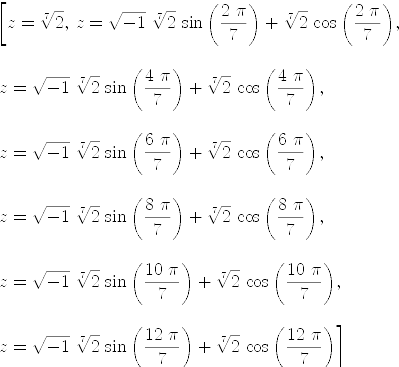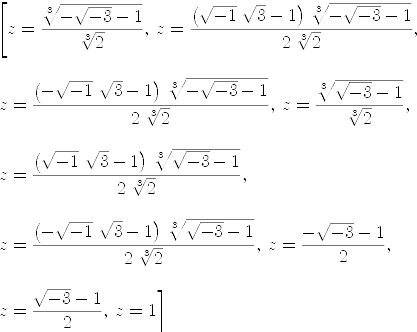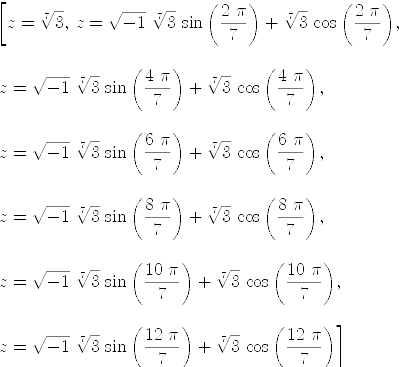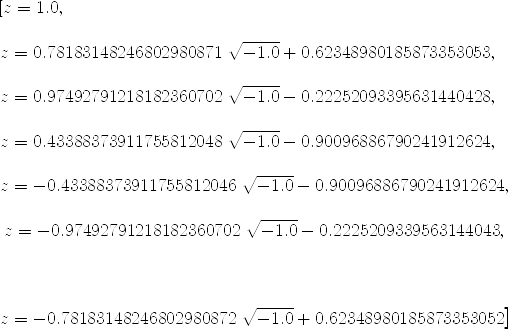|
|
|
last edited 18 years ago by kratt6 |
Edit detail for #12 radicalSolve fails to find all roots ? revision 1 of 2
| 1 2 | ||
|
Editor:
Time: 2007/11/17 21:55:37 GMT-8 |
||
| Note: | ||
changed: - From -- William Sit Subject -- Re: [Axiom-developer] [Q] radicalSolve fails to find all roots ? Date -- Mon, 17 Jan 2005 16:31:52 -0500 These are NOT bugs! But the following may be! Consider the equation $z^n=1$ for $n=7$ \begin{axiom} radicalSolve(z^7=2) \end{axiom} comments Of course, these are correct solutions by Euler's Formula. A bit surprising that radicalSolve invokes these for $z^7=2$ and not for $z^7=1$; when $n$ is 7, these trignometric values are not embeddable in a tower of "solvable" extensions. That is, these are not solutions expressible in terms of radicals (of *real* numbers) and arithmetic alone. Put another way, the regular 7-gon is not constructible by compass and ruler alone. From: - http://mathworld.wolfram.com/ConstructiblePolygon.html - http://mathworld.wolfram.com/TrigonometryAngles.html A necessary and sufficient condition that a regular n-gon be constructible is that phi(n) be a power of 2, where phi(n) is the totient function (Krízek 2001, p. 34):: n = 1 2 3 4 5 6 7 8 9 10 11 12 13 14 15 16 17 18 19 20 phi= 1 1 2 2 4 2 6 4 6 4 10 4 12 6 8 8 16 6 18 8 bad= x x x x x x x Vladimir's "not good" values are n = 7 11 13 14 15 17 19 So if you compare the constructible regular n-gons, you can see why Axiom's results are reasonable: radicalSolve only finds solutions that are expressible in terms of radicals and arithmetic operations. It did not find those for $n = 15$ and $17$ probably (I am guessing) because at the time of implementation, these constructions were not known (at least to the programmer). On the other hand, for $n = 9, 18$, the solutions are expressible in radicals only if radicals of *complex* numbers are allowed and Axiom found those (perhaps it shouldn't?). The expansion for $(-1)^{1/7}$ that Vladimir gave involves radicals of complex numbers, as theory predicts. When Axiom cannot find solutions, it is (presumably) a PROOF that the other solutions are NOT solvable by radicals (using *real* numbers), or at least, there is no known proof that it is solvable at the time of implementation. (That is why I am surprised at the above result for $z^7=2$). In other words, rather than viewing the answer for $z^7=1$ as a bug, we should view the answers for $z^7=2$, $z^7=3$ (and may be even $z^9=1$, $z^{18}=1$) as bugs! Still, the package should be upgraded. ------------------- \begin{axiom} radicalSolve(z^9=1,z) radicalSolve(z^7=3) radicalSolve(z^7=1.) radicalSolve(z^6+z^5+z^4+z^3+z^2+z+1=0) \end{axiom} William From BobMcElrath Mon Jan 17 22:15:05 -0600 2005 From: Bob McElrath Date: Mon, 17 Jan 2005 22:15:05 -0600 Subject: (new) Message-ID: <20050118041514.GA30214@mcelrath.org> In-Reply-To: <20050117210215-0600@page.axiom-developer.org> anonymous [mathaction@axiom-developer.org] wrote: > When Axiom cannot find solutions, it is (presumably) a PROOF that the other > solutions are NOT solvable by radicals (using *real* numbers), or at least, > there is no known proof that it is solvable at the time of implementation. (That > is why I am surprised at the above result for z^7=2). Given Axiom's assumptions about input in this problem, why cannot I do this: \begin{axiom} z:Complex(Float) radicalSolve(z^7=1) z:Integer radicalSolve(z^7=1) z:Variable(Complex(Float)) radicalSolve(z^7=1) z:Symbol(Complex(Float)) radicalSolve(z^7=1) \end{axiom} ...and get the appropriate answers? Also this behind-the-scenes behavior where the answer depends on the input type or assumptions is undesirable, and surprising to casual users. When algorithms must make assumptions about the type of a Variable or Symbol, at the very least a message should be printed indicating that the assumption was made. An even better algorithm would print a message, then keep that assumption for the remainder of the calculation... From unknown Mon Jan 17 22:19:23 -0600 2005 From: Date: Mon, 17 Jan 2005 22:19:23 -0600 Subject: Original question Message-ID: <20050117221923-0600@page.axiom-developer.org> .................................................................... Obviously, all the roots of the equation $z^7 = 1$ can be expressed in radicals, and Mathematica can easily produce the explicit expressions in terms of radicals:: Solve[z^7 == 1, z] {{z -> 1}, {z -> -(-1)^(1/7)}, {z -> (-1)^(2/7)}, {z -> -(-1)^(3/7)}, {{z -> {z -> (-1)^(4/7)}, {z -> -(-1)^(5/7)}, {z -> (-1)^(6/7)}} To save the space, below the only example is given:: FunctionExpand[ComplexExpand[-(-1)^(1/7)]] (1/2)*((1/3)*((1/2)*(-1 + I*Sqrt[7]) + ((-1 + I*Sqrt[3])*((1/2)*(-1 + I*Sqrt[7]) + (1/2)*(-1 - I*Sqrt[7])*((1/2)*(-1 + I*Sqrt[3]) + (1/4)*(-1 + I*Sqrt[3])^2)))/(2*(6 + (3/4)*(-1 + I*Sqrt[3])*(-1 + I*Sqrt[7]) + (1/2)*(-1 - I*Sqrt[7])*(1 + (3/4)*(-1 + I*Sqrt[3])^2))^(1/3)) + (1/4)*(-1 + I*Sqrt[3])^2*(6 + (3/4)*(-1 + I*Sqrt[3])*(-1 + I*Sqrt[7]) + (1/2)*(-1 - I*Sqrt[7])*(1 + (3/4)*(-1 + I*Sqrt[3])^2))^(1/3)) +(1/3)*((1/2)*(1 + I*Sqrt[7]) - ((-1 + I*Sqrt[3])^2*((1/2)*(-1 -I*Sqrt[7]) + (1/2)*(-1 + I*Sqrt[7])*((1/2)*(-1 + I*Sqrt[3]) + (1/4)*(-1 + I*Sqrt[3])^2)))/(4*(6 + (3/4)*(-1 + I*Sqrt[3])*(-1 - I*Sqrt[7]) + (1/2)*(-1 + I*Sqrt[7])*(1 + (3/4)*(-1 + I*Sqrt[3])^2))^(1/3)) -(1/2)*(-1 + I*Sqrt[3])*(6 + (3/4)*(-1 + I*Sqrt[3])*(-1 - I*Sqrt[7]) + (1/2)*(-1 + I*Sqrt[7])*(1 + (3/4)*(-1 + I*Sqrt[3])^2))^(1/3))) + (1/2)*((1/3)*((1/2)*(-1 + I*Sqrt[7]) + ((-1 + I*Sqrt[3])*((1/2)*(-1 + I*Sqrt[7]) + (1/2)*(-1 - I*Sqrt[7])*((1/2)*(-1 + I*Sqrt[3]) + (1/4)*(-1 + I*Sqrt[3])^2)))/(2*(6 + (3/4)*(-1 + I*Sqrt[3])*(-1 + I*Sqrt[7]) + (1/2)*(-1 - I*Sqrt[7])*(1 + (3/4)*(-1 + I*Sqrt[3])^2))^(1/3)) +(1/4)*(-1 + I*Sqrt[3])^2*(6 + (3/4)*(-1 + I*Sqrt[3])*(-1 + I*Sqrt[7]) + (1/2)*(-1 - I*Sqrt[7])*(1 + (3/4)*(-1 + I*Sqrt[3])^2))^(1/3)) + (1/3)*((1/2)*(-1 - I*Sqrt[7]) +((-1 + I*Sqrt[3])^2*((1/2)*(-1 - I*Sqrt[7]) + (1/2)*(-1 + I*Sqrt[7])*((1/2)*(-1 + I*Sqrt[3]) + (1/4)*(-1 + I*Sqrt[3])^2)))/(4*(6 + (3/4)*(-1 + I*Sqrt[3])*(-1 - I*Sqrt[7]) + (1/2)*(-1 + I*Sqrt[7])*(1 + (3/4)*(-1 + I*Sqrt[3])^2))^(1/3)) +(1/2)*(-1 + I*Sqrt[3])*(6 + (3/4)*(-1 + I*Sqrt[3])*(-1 - I*Sqrt[7]) + (1/2)*(-1 + I*Sqrt[7])*(1 + (3/4)*(-1 + I*Sqrt[3])^2))^(1/3))) According to the AXIOM Book-- Use radicalSolve if you want your solutions expressed in terms of radicals. However, already for z^7 = 1 this is not so, \begin{axiom} radicalSolve(z^7=1, z) \end{axiom} and the problem exists for 11, 13, 14, 15, 17, 19 etc \begin{axiom} for i in 1..20 repeat print([i,#radicalSolve(z^i=1,z)]) \end{axiom} :: [1,1] [2,2] [3,3] [4,4] [5,5] [6,6] [7,1] <-- not good [8,8] [9,9] [10,10] [11,1] <-- not good [12,12] [13,1] <-- not good [14,2] <-- not good [15,7] <-- not good [16,16] [17,1] <-- not good [18,18] [19,1] <-- not good [20,20] Best, Vladimir
- From
- William Sit
- Subject
- Re: [Axiom-developer]? [Q]? radicalSolve fails to find all roots ?
- Date
- Mon, 17 Jan 2005 16:31:52 -0500
These are NOT bugs! But the following may be! Consider the equation ![]() for
for
![]()
axiomradicalSolve(z^7=2)
 | (1) |
comments
Of course, these are correct solutions by Euler's Formula. A bit surprising that
radicalSolve invokes these for ![]() and not for
and not for ![]() ; when
; when ![]() is 7, these
trignometric values are not embeddable in a tower of "solvable" extensions. That
is, these are not solutions expressible in terms of radicals (of real numbers)
and arithmetic alone. Put another way, the regular 7-gon is not constructible by
compass and ruler alone. From:
is 7, these
trignometric values are not embeddable in a tower of "solvable" extensions. That
is, these are not solutions expressible in terms of radicals (of real numbers)
and arithmetic alone. Put another way, the regular 7-gon is not constructible by
compass and ruler alone. From:
- http://mathworld.wolfram.com/ConstructiblePolygon.html
- http://mathworld.wolfram.com/TrigonometryAngles.html
A necessary and sufficient condition that a regular n-gon be constructible is that phi(n) be a power of 2, where phi(n) is the totient function (Krízek 2001, p. 34):
n = 1 2 3 4 5 6 7 8 9 10 11 12 13 14 15 16 17 18 19 20 phi= 1 1 2 2 4 2 6 4 6 4 10 4 12 6 8 8 16 6 18 8 bad= x x x x x x x Vladimir's "not good" values are n = 7 11 13 14 15 17 19
So if you compare the constructible regular n-gons, you can see why Axiom's
results are reasonable: radicalSolve only finds solutions that are expressible
in terms of radicals and arithmetic operations. It did not find those for ![]() and
and ![]() probably (I am guessing) because at the time of implementation, these
constructions were not known (at least to the programmer). On the other hand,
for
probably (I am guessing) because at the time of implementation, these
constructions were not known (at least to the programmer). On the other hand,
for ![]() , the solutions are expressible in radicals only if radicals of
complex numbers are allowed and Axiom found those (perhaps it shouldn't?). The
expansion for
, the solutions are expressible in radicals only if radicals of
complex numbers are allowed and Axiom found those (perhaps it shouldn't?). The
expansion for ![]() that Vladimir gave involves radicals of complex
numbers, as theory predicts.
that Vladimir gave involves radicals of complex
numbers, as theory predicts.
When Axiom cannot find solutions, it is (presumably) a PROOF that the other
solutions are NOT solvable by radicals (using real numbers), or at least,
there is no known proof that it is solvable at the time of implementation. (That
is why I am surprised at the above result for ![]() ).
).
In other words, rather than viewing the answer for ![]() as a bug, we should
view the answers for
as a bug, we should
view the answers for ![]() ,
, ![]() (and may be even
(and may be even ![]() ,
, ![]() ) as bugs!
) as bugs!
Still, the package should be upgraded.
-------------------
axiomradicalSolve(z^9=1,z)
 | (2) |
axiomradicalSolve(z^7=3)
 | (3) |
axiomradicalSolve(z^7=1.) 7 WARNING (genufact): No known algorithm to factor ? - 1.0 , trying square-free.
 | (4) |
axiomradicalSolve(z^6+z^5+z^4+z^3+z^2+z+1=0)
| (5) |
William
When Axiom cannot find solutions, it is (presumably) a PROOF that the other solutions are NOT solvable by radicals (using real numbers), or at least, there is no known proof that it is solvable at the time of implementation. (That is why I am surprised at the above result for z^7=2).
Given Axiom's assumptions about input in this problem, why cannot I do this:
axiomz:Complex(Float) radicalSolve(z^7=1) z:Integer radicalSolve(z^7=1) z:Variable(Complex(Float)) radicalSolve(z^7=1) z:Symbol(Complex(Float)) radicalSolve(z^7=1) Category, domain or package constructor ComplexFloat is not available.
...and get the appropriate answers?
Also this behind-the-scenes behavior where the answer depends on the input type or assumptions is undesirable, and surprising to casual users. When algorithms must make assumptions about the type of a Variable or Symbol, at the very least a message should be printed indicating that the assumption was made.
An even better algorithm would print a message, then keep that assumption for the remainder of the calculation...
- Original question....................................................................
- Mon, 17 Jan 2005 22:19:23 -0600 reply
Obviously, all the roots of the equation ![]() can be expressed in
radicals, and Mathematica can easily produce the explicit expressions
in terms of radicals:
can be expressed in
radicals, and Mathematica can easily produce the explicit expressions
in terms of radicals:
Solve[z^7 == 1, z]
{{z -> 1}, {z -> -(-1)^(1/7)}, {z -> (-1)^(2/7)}, {z -> -(-1)^(3/7)},
{{z -> {z -> (-1)^(4/7)}, {z -> -(-1)^(5/7)}, {z -> (-1)^(6/7)}}
To save the space, below the only example is given:
FunctionExpand[ComplexExpand[-(-1)^(1/7)]] (1/2)*((1/3)*((1/2)*(-1 + I*Sqrt[7]) + ((-1 + I*Sqrt[3])*((1/2)*(-1 + I*Sqrt[7]) + (1/2)*(-1 - I*Sqrt[7])*((1/2)*(-1 + I*Sqrt[3]) + (1/4)*(-1 + I*Sqrt[3])^2)))/(2*(6 + (3/4)*(-1 + I*Sqrt[3])*(-1 + I*Sqrt[7]) + (1/2)*(-1 - I*Sqrt[7])*(1 + (3/4)*(-1 + I*Sqrt[3])^2))^(1/3)) + (1/4)*(-1 + I*Sqrt[3])^2*(6 + (3/4)*(-1 + I*Sqrt[3])*(-1 + I*Sqrt[7]) + (1/2)*(-1 - I*Sqrt[7])*(1 + (3/4)*(-1 + I*Sqrt[3])^2))^(1/3)) +(1/3)*((1/2)*(1 + I*Sqrt[7]) - ((-1 + I*Sqrt[3])^2*((1/2)*(-1 -I*Sqrt[7]) + (1/2)*(-1 + I*Sqrt[7])*((1/2)*(-1 + I*Sqrt[3]) + (1/4)*(-1 + I*Sqrt[3])^2)))/(4*(6 + (3/4)*(-1 + I*Sqrt[3])*(-1 - I*Sqrt[7]) + (1/2)*(-1 + I*Sqrt[7])*(1 + (3/4)*(-1 + I*Sqrt[3])^2))^(1/3)) -(1/2)*(-1 + I*Sqrt[3])*(6 + (3/4)*(-1 + I*Sqrt[3])*(-1 - I*Sqrt[7]) + (1/2)*(-1 + I*Sqrt[7])*(1 + (3/4)*(-1 + I*Sqrt[3])^2))^(1/3))) + (1/2)*((1/3)*((1/2)*(-1 + I*Sqrt[7]) + ((-1 + I*Sqrt[3])*((1/2)*(-1 + I*Sqrt[7]) + (1/2)*(-1 - I*Sqrt[7])*((1/2)*(-1 + I*Sqrt[3]) + (1/4)*(-1 + I*Sqrt[3])^2)))/(2*(6 + (3/4)*(-1 + I*Sqrt[3])*(-1 + I*Sqrt[7]) + (1/2)*(-1 - I*Sqrt[7])*(1 + (3/4)*(-1 + I*Sqrt[3])^2))^(1/3)) +(1/4)*(-1 + I*Sqrt[3])^2*(6 + (3/4)*(-1 + I*Sqrt[3])*(-1 + I*Sqrt[7]) + (1/2)*(-1 - I*Sqrt[7])*(1 + (3/4)*(-1 + I*Sqrt[3])^2))^(1/3)) + (1/3)*((1/2)*(-1 - I*Sqrt[7]) +((-1 + I*Sqrt[3])^2*((1/2)*(-1 - I*Sqrt[7]) + (1/2)*(-1 + I*Sqrt[7])*((1/2)*(-1 + I*Sqrt[3]) + (1/4)*(-1 + I*Sqrt[3])^2)))/(4*(6 + (3/4)*(-1 + I*Sqrt[3])*(-1 - I*Sqrt[7]) + (1/2)*(-1 + I*Sqrt[7])*(1 + (3/4)*(-1 + I*Sqrt[3])^2))^(1/3)) +(1/2)*(-1 + I*Sqrt[3])*(6 + (3/4)*(-1 + I*Sqrt[3])*(-1 - I*Sqrt[7]) + (1/2)*(-1 + I*Sqrt[7])*(1 + (3/4)*(-1 + I*Sqrt[3])^2))^(1/3)))
According to the AXIOM Book--
Use radicalSolve if you want your solutions expressed in terms of radicals.
However, already for z^7 = 1 this is not so,
axiomradicalSolve(z^7=1, z)
| (6) |
and the problem exists for 11, 13, 14, 15, 17, 19 etc
axiomfor i in 1..20 repeat print([i,#radicalSolve(z^i=1,z)]) [1,1] [2,2] [3,3] [4,4] [5,5] [6,6] [7,1] [8,8] [9,9] [10,10] [11,1] [12,12] [13,1] [14,2] [15,7] [16,16] [17,1] [18,18] [19,1] [20,20]
[1,1]
[2,2]
[3,3]
[4,4]
[5,5]
[6,6]
[7,1] <-- not good
[8,8]
[9,9]
[10,10]
[11,1] <-- not good
[12,12]
[13,1] <-- not good
[14,2] <-- not good
[15,7] <-- not good
[16,16]
[17,1] <-- not good
[18,18]
[19,1] <-- not good
[20,20]
Best,
Vladimir